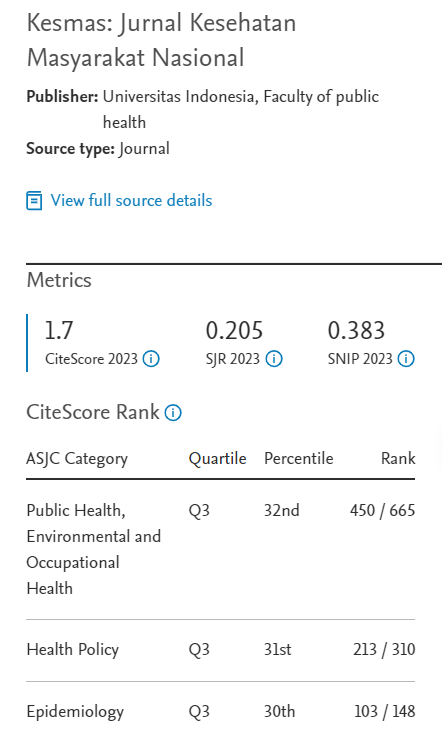Abstract
Dengue Hemorrhagic Fever (DHF) is transmitted through the bites of Aedes aegypti and Aedes albopictus mosquitoes and is still becoming endemic in Bogor District. This quantitative correlation study with an ecological approach aimed to analyze how DHF incidence is influenced by climate factors, population density, Larvae Free Rate (LFR), and the area altitude factor. Secondary data were obtained from the Bogor Regency Health Office; the Central Bureau of Statistics of Bogor District; and the Meteorology, Climatology, and Geophysics Agency. In this study, the spatial analysis method was also used, but only on the area altitude factor. The study’s results showed a significant relationship between climate factors, such as air humidity at a Time Lag of 0 months (r=0.394) and the altitude factor (r=-0.350), and DHF incidence in the Bogor District from 2017 to 2022. Spatial data shows that in districts with lower altitudes, such as Cibinong, Cileungsi, and Gunung Putri, DHF incidence tends to be higher. The Bogor District Health Office, together with the community, may enhance efforts to prevent and control DHF, especially during seasonal transitions and in areas with lower altitudes. Cross-sector collaboration with the Meteorology, Climatology, and Geophysics Agency is also necessary to remain vigilant during climate fluctuations.
References
1. World Health Organization. Dengue and severe dengue. Geneva: World Health Organization; 2021.
2. Kularatne SA, Dalugama C. Dengue infection: Global importance, immunopathology and management. Clin Med (Lond). 2022; 22 (1): 9- 13. DOI: 10.7861/clinmed.2021-0791
3. World Health Organization. Dengue Guidelines for Diagnosis, Treatment, Prevention and Control: New Edition. Geneva: World Health Organization. 2009.
4. Kementerian Kesehatan Republik Indonesia. Situasi Penyakit Demam Berdarah di Indonesia Tahun 2017. Jakarta: Kementerian Kesehatan Republik Indonesia; 2018.
5. Dinas Kesehatan Provinsi Jawa Barat. Profil Kesehatan Jawa Barat Tahun 2022. Bandung: Dinas Kesehatan Provinsi Jawa Barat; 2023.
6. Dinas Kesehatan Kabupaten Bogor. Profil Kesehatan Kabupaten Bogor Tahun 2019. Bogor: Dinas Kesehatan Kabupaten Bogor; 2020.
7. Murwanto B, Trigunarso SI, Purwono P. Faktor Lingkungan Sosial, Lingkungan Fisik, dan Pengendalian Program DBD terhadap Kejadian Demam Berdarah Dengue (DBD). J Kesehat. 2019; 10 (3): 453–458. DOI: 10.26630/jk.v10i3.1424
8. Komaling D, Sumampouw OJ, Sondakh RC. Determinan Kejadian Demam Berdarah Dengue di Kabupaten Minahasa Selatan Tahun 2016-2018. 2020; 1 (1): 57–64. DOI: 10.35801/ijphcm.1.1.2020.27247
9. Kementerian Kesehatan Republik Indonesia. Pedoman Pencegahan dan Pengendalian Demam Berdarah Dengue di Indonesia. Jakarta: Kementerian Kesehatan Republik Indonesia; 2017.
10. Naish S, Dale P, Mackenzie JS, et al. Climate change and dengue: A critical and systematic review of quantitative modelling approaches. BMC Infect Dis. 2014; 14: 167. DOI: 10.1186/1471-2334-14-167
11. Juwita CP. Variabilitas Iklim dengan Kejadian Demam Berdarah Dengue di Kota Tangerang. Gorontalo J Public Health. 2020; 3 (1): 8- 14. DOI: 10.32662/gjph.v3i1.914
12. Daswito R, Lazuardi L, Nirwati H. Analisis Hubungan Variabel Cuaca dengan Kejadian DBD di Kota Yogyakarta. J Kesehat Terpadu Integr Health J. 2019; 10 (1): 1–7. DOI: 10.32695/JKT.V10I1.24
13. Kurniawati N, Yudhastuti R. Hubungan Iklim dan Angka Bebas Jentik dengan Kejadian Demam Berdarah Dengue di Puskesmas Putat Jaya. JIKMH. 2016; 5 (2): 157-166. DOI: 10.33475/jikmh.v5i2.175
14. Pinontoan O. Pengendalian Vektor. Manado: Unstrat Press; 2018.
15. Nuraini N, Fauzi IS, Fakhruddin M, et al. Climate-based dengue model in Semarang, Indonesia: Predictions and descriptive analysis. Infect Dis Model. 2021; 6: 598-611. DOI: 10.1016/j.idm.2021.03.005
16. Abdelrazec A, Gumel AB. Mathematical assessment of the role of temperature and rainfall on mosquito population dynamics. J Math Biol. 2017; 74 (6): 1351-1395. DOI: 10.1007/s00285-016-1054-9
17. Widawati M, Fuadiyah ME. Faktor Iklim Berpengaruh Terhadap Kejadian Demam Berdarah Dengue di Kota Cimahi Tahun 2004- 2013. Spirakel. 2019; 10 (2): 86-96.
18. Gama ZP, Nakagoshi N. Climatic Variability and Dengue Haemaorrhagic Fever Incidence in Nganjuk District, East Java, Indonesia. Acta Biol Malaysiana. 2013; 2 (1): 31–39. DOI: 10.7593/abm/2.1.31
19. Hasanah H, Susanna D. Weather Implication for Dengue Fever in Jakarta, Indonesia 2008-2016. KnE Life Sci. 2019; 4 (10): 184. DOI: 10.18502/kls.v4i10.3719
20. Rau MJ, Komariyah S, Pitriani P. The Relationship of the Climate Change with the Event of Dengue Hemorrhagic Fever in Palu City Year 2013-2017. Preventif J Kesehat Masy. 2019; 10 (2): 83–94. DOI: 10.22487/preventif.v10i2.123
21. Nuranisa R, Maryanto YB, Isfandiari MA. Correlation of Free Larvae Index and Population Density with Dengue Fever Incidence Rate. Indones J Public Heal. 2022; 17 (3): 477–487.
22. Tamengkel HV, Sumampouw OJ, Pinontoan OR. Ketinggian Tempat dan Kejadian Demam Berdarah Dengue. Indonesian J Public Health Commun Med. 2020; 1 (1): 12–18. DOI: 10.35801/ijphcm.1.1.2020.26642
23. Paomey VC, Nelwan JE, Kaunang WPJ. Sebaran Penyakit Demam Berdarah Dengue Berdasarkan Ketinggian dan Kepadatan Penduduk di Kecamatan Malalayang Kota Manado Tahun 2019. Kesmas J Kesehat Masy Univ Sam Ratulangi. 2019; 8 (6): 521–527.
Recommended Citation
Wulandari RA , Rahmawati T , Asyary A ,
et al.
Analysis of Climate and Environmental Risk Factors on Dengue Hemorrhagic Fever Incidence in Bogor District.
Kesmas.
2023;
18(3):
209-214
DOI: 10.21109/kesmas.v18i3.7351
Available at:
https://scholarhub.ui.ac.id/kesmas/vol18/iss3/9







